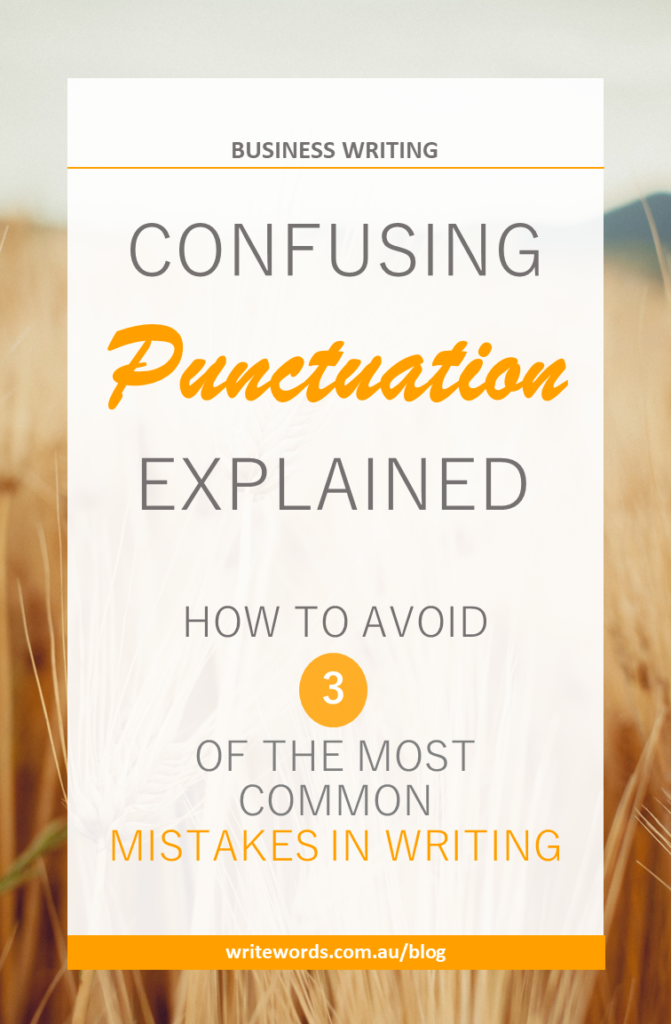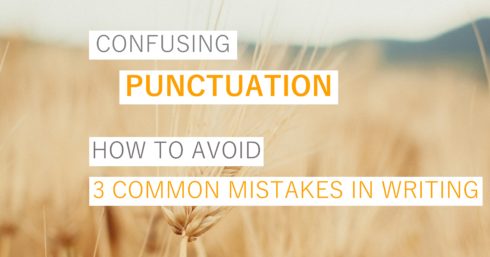Confusing punctuation – how to avoid 3 of the most common mistakes in writing.
The most misunderstood punctuation – and how to get it right.
There are rules of writing, and there are rules. Intentional creative licence aside, a writing blunder – when in the public domain – can scream ‘unprofessional’.
At stake is the writer’s credibility – not to mention the possibility of facing the wrath of a ‘writer’ who knows better.
So that your writing productivity doesn’t suffer from fear of a writing mishap, today I’ll clear up three of the most confusing punctuation dilemmas:
- the apostrophe
- the semicolon, and
- the dash.

Apostrophes
Let’s start with the ultimate in punctuation misuse.
You see it everywhere – the out-of-place apostrophe. In ads, on signs, blogs, social media, business websites – you name it.
Sometimes they’re on the wrong side of an ‘s’; mostly, they shouldn’t even be there. Did you know an apostrophe has just two uses?
Two reasons to use an apostrophe
1. To indicate missing letters or numbers in a contraction:
| You are | You’re |
| We are | We’re |
| I am | I’m |
| They are | They’re |
| It is | It’s |
| I have | I’ve |
| Let us | Let’s |
| There is | There’s |
| Cannot | Can’t |
| Do not | Don’t |
| Were not | Weren’t |
| Would not | Wouldn’t |
2. To show ownership or possession when used with an ‘s’:
- The CEO’s whitepaper is due tomorrow.
- The bestselling book’s publisher is assisting with my employees’ publications.
Tip: If more than one thing or person has possession, the apostrophe usually goes after the ‘s’ – see employees’ – above.
Its is a rare exception – its is the possessive of it.
Whose is another – whose is the possessive of who (belonging to him or her).
- The cat chased its tail. The mouse, whose name was Mickey, was friends with the cat.
Apostrophes and numbers
Rarely should apostrophes and numbers mix. In this example, you might be tempted to add an apostrophe between the number and the ‘s’. Don’t!
- In the 1990s, when I was in my 20s, I loved music and fashion of the ’80s.
The only time an apostrophe is required is when the number is shortened – for example, from 1980s to ’80s.
Recap
Remember: only two uses for an apostrophe:
- To indicate missing letters or numbers in a contraction: can’t, you’re, I’d, ’70s.
- To show ownership or possession when used with an ‘s’: The bestselling book’s publisher is assisting with my employees’ publications.
FREE MINI COURSE – write faster and with more confidence in 3 simple steps.
Watch now!
Semicolons ( ; ) v Colons ( : )
In my opinion, the poor old semicolon ( ; ) is misused almost as often as the apostrophe.
Semicolons ( ; )
- Indicate a pause bigger than a comma and smaller than a full stop; the section of text on either side of the semicolon should be able to stand alone as its own sentence. How often you use a semicolon is up to you; you can often replace it with a dash (see below) or a full stop. See example 1.
- Separate list items that require a comma. See example 2.
A semicolon should never be used before bullet points.
Colons ( : )
Come before an explanation, which can include a list (eg bullet points) or an example. See example 2.
Examples
- I travel frequently for business; I believe meeting in person is more efficient than Skype or email.
- When preparing for a business trip, I always write a list which includes: what to pack; my flight, hotel and taxi itineraries; people I’ll be meeting, such as friends or colleagues; best restaurants; and things to do on the weekend.
Recap
The most common mistake with semicolons is using them before bullet points. Ensure you save this task for the colon ( : ).
Dashes v Hyphens
The dash is one of my favourites for keeping readers onside – it’s easy on the eye and it makes your writing punchy (and easy to digest). Not to be confused with the shorter hyphen, here’s how I make the most of this awesome punctuation mark.
Dash
1. Instead of commas, you can use the more attractive dash to break up a sentence:
- Don’t overcomplicate your writing by using big words and long sentences – otherwise your writing is likely to become convoluted.
2. Explain a point – instead of parentheses (brackets):
- Your language – the words you use – depends on who you’re writing for.
- This doesn’t mean your communication item needs to be short or abrupt – concise writing allows you to include everything you want to say, minus the clutter.
3. Explain a point or provide an example – instead of a colon ( : ):
- There may be no getting away from this one – if you constantly convince yourself you’re not ready to start writing, you may need to lock yourself away.
4. Emphasise a point:
- Writing well requires concentration – and dedication.
- At stake is the writer’s credibility – not to mention the possibility of facing the wrath of a ‘writer’ who knows better.
For the punctuation enthusiasts
If you do embrace the dash, you need to decide whether you’ll use the en dash (shorter and surrounded by space) or the em dash (longer and adjoining the word on either side).
In my opinion this is not so much a writing rule, but a decision based on your own personal style. You can see I prefer to use the shorter en dash.
Hyphen
So where does the hyphen fit into all this? Unlike the en-em dash dilemma, the hyphen’s usage is hard and fast.
Used primarily to cement words together, it has many functions, so if in doubt, look it up. Here are some of the hyphen’s most common uses:
1. Two or more words are hyphenated to modify (usually describe) a noun. This is called a compound adjective, and the hyphen avoids confusion:
- The on-campus tour for undergraduates will start at 3pm.
- I have a two-year-old daughter.
Generally, a hyphen is not required when the modifier comes after the noun:
- The undergraduate tour will start on campus at 3pm.
- My daughter is two years old.
Exception
If an ‘ly’ word (adverb) comes before the adjective (descriptive word), it won’t need a hyphen:
- Highly regarded entrepreneur
- Globally focused blog
2. When using numbers, hyphenate times, distances or other quantities:
- 6.05-6.35pm
- 2012-2018
- 20-30 people
3. For clarity, hyphenate words that contain a prefix with a double vowel (other than ‘o’):
- Pre-eminent
- Re-assess
- Coordinate
Be aware of words that change meaning with the addition of a hyphen:
- Recover and re-cover
- Relay and re-lay
- Resign and re-sign
Recap
Embrace the dash – make it work for you, but don’t confuse it with a hyphen.
There you have it – my top three misused punctuation marks. What are yours? Let us know in the comments below!
Want to improve your writing?
Join the WriteWell community and receive valuable resources that will improve your writing, including tips, cheat sheets and more. Here’s a taster:
- Write less, say more: Make more impact by writing fewer words
- Write with purpose: 5 ways to strategically target your reader
- Captivate your readers: How to write compelling content
- The power of simplicity: How to keep even the most complex writing task simple
Receive more writing tips – free into your inbox. Sign me up!
Share the love!
Like this writing tip? Share it with your friends and colleagues.

